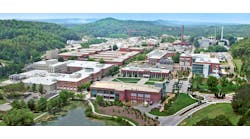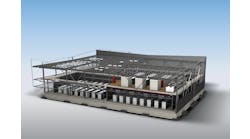ASHBURN, Va. – The data center industry has a history of uninspired visual design for its buildings, a legacy of its emphasis on uptime and security.
Many of the data centers of 2019 are easier on the eyes than facilities built 10 years ago. Others retain the traditional “concrete bunker” design motif.
The industry may need to continue to raise its design game, as the visibility of huge data center campuses is prompting neighbors and public officials to demand more attractive buildings.
Data center design emerged as a key discussion point recently in Loudoun County, Virginia, which is home to the world’s largest concentration of data centers. When the county created a new master development plan, one of the hot topics was the appearance of data center buildings.
With more than 100 facilities, data centers shape the visual landscape of Ashburn’s Data Center Alley. The community wants the industry to do better.
Buddy Rizer, the county’s Executive Director of Economic Development, says the data center industry has responded to residents’ concerns and improved its design on public-facing buildings.
“We’ve seen a lot of change over the last 10 to 15 years,” said Rizer. “We’ve learned a lot along the way. It’s an evolutionary industry and the buildings today are on a different level of efficiency and design.”
Some members of the Loudoun County Board of Supervisors want that evolution to happen faster.
“You know the number one complaint I’ve got in the last four months?” asked supervisor Ron Meyer. “It wasn’t traffic. It wasn’t tolls. It was data center design.
“That’s not to say people don’t want data centers here,” said Meyer, who represents the Broad Run district in Ashburn. “What it means is that we can make sure that data centers are appropriately designed and appropriately landscaped to fit in with our community.”
A Higher Community Profile
The discussion in Loudoun highlights the growing role for data centers as part of the urban and suburban landscape. As the Internet and cloud computing boost the digital economy, we’ll see more data centers in more places.
As this process evolves, the design and exterior appearance of these facilities will become more important. As the data center industry becomes part of a community, it has a vested interest in the profile of its facilities and its concerns.
“The data center industry has been a good partner,” said Rizer. “We went through this process in 2015, where the industry was at the table and we came up with design standards. I would argue that these design standards are working and data centers are light years ahead of where they were just a few years ago. The industry is more than happy to have these conversations.”
“This is not the data center industry of 20 years ago,” said Phyllis Randall, the chairperson of the Board of Supervisors. “When the industry responds to elected officials and the voice of the people, we should act like they have responded. And they have.”
The cooling towers and equipment yard at the ACC7 data center, which faces the road in Ashburn. (Photo: Rich Miller)
The evolution of data center visual design is clearly visible in a single intersection on Waxpool Road. On one side of the street, a raised earthen berm and scattered trees partially obscure a row of industrial cooling towers and a giant white water storage tank in the equipment yard behind the ACC7 facility. Across the street is the RagingWire VA3 data center, with its distinctive blue-and-gold facade, fronted by a pond.
The VA3 facility, which was completed in 2018, has been honored by Loudoun County as “a pace setter in its site planning and visual design.” The cooling towers across the way … not so much. Their placement was guided by county guidance on the design of data center campuses.
“Originally, we made the buildings face the internal roads,” said Rizer. “Now we understand that there are other ways to do it.”
“If they were still building the data centers we see when we drive down Waxpool today, I think my hair would be on fire,” said Randall. “Those buildings are just horrible.
”RagingWire does not look like the data centers we saw 20 years ago,” she added. “It’s a totally different industry today. Data centers and people who work in data centers are now an integral part of our community.”
Security Through Obscurity
That wasn’t always the case. In the 1990s, data center buildings were meant to be as anonymous as possible, blending into the industrial landscape. Security was the top priority, and many tenants embraced the idea of “security through obscurity,” with the building concealed by deep setbacks, elaborate security gates and no exterior signage or branding.
Early data centers were often concrete bunkers, with no windows. When arriving for a tour, the first challenge was figuring out if you were at the correct building.
This fountain and building at Equinix DC12 reflects the data center industry’s efforts to present a less industrial facade in Ashburn. (Photo: Equinix)
A growing number of data center builders have updated their designs to present a more attractive facade, including better landscaping. Some, like RagingWire, have even been cited for their designs. But best practices are unevenly applied, and some providers seem to be just fine with nondescript buildings.
This was on Meyer’s mind as Loudoun updated its master plan.
In an early planning meeting, Meyer introduced a rule change that would have required data centers to gain additional legislative approval in some areas of the county, a step which would slow the development process. The supervisors reconsidered that decision, opting to update zoning ordinances to include “performance standards for data centers to address design, landscaping, and compatibility.”
The compromise passed unanimously, creating a roadmap for improved design standards without slowing the approval process. As zoning ordinances are updated, data center operators will have input and be able to respond to community concerns.
“The key takeaway for me is that the data center industry will be at the table, and will be heard,” said Rizer.
Balacing the Tax Benefits
In many ways, Loudoun County is the best place in the world to have this conversation, as it has seen major benefits from data center development.
In the 2018 fiscal year, Loudoun County collected $195 million in taxes on business computer equipment, about $40 million more than expected. The surge in tax revenues will continue into 2019, with tax revenues from data centers expected to surpass $250 million.
The county just adopted a budget that includes a four-cent reduction in the property tax rate (from $1.08 to $1.04), a $76 million increase in funding for county schools, and the addition of 204 new positions in county government.
Supervisors were acutely aware of this during the discussion of the comprehensive plan. Supervisor Kristen Umstaddt noted that residents may complain about data centers’ appearance, but “almost none of those people want to pay higher taxes.
“The data center industry has enabled us to keep our tax rate down,” said Umstattdt. “We have to be very mindful that if we start putting a higher level of restrictions on them, we could begin to lose them to jurisdictions who are trying to compete hard with us.”
Local officials and industry executives have worked through these concerns before. In 2013, residents showed up at local meetings to complain about the proximity of data centers to housing developments, noise from diesel backup generators, and the facilities’ lack of aesthetic appeal.
In April 2014, the Loudoun Board of Supervisors passed a measure that made data centers a “by right” permitted use in specific areas, providing clarity on future development. The board also created guidelines on screening around equipment yards, as well as improvements to data center facades to improve their appearance.
Progress Remains Uneven
That has resulted in broad improvements in design, but it’s not universal, as Meyers noted.
“The idea that we don’t need to change things because the data center industry is doing this itself is not accurate,” he said. “There’s a couple of companies that are doing a fantastic job. CyrusOne and QTS are doing a fantastic job. Sentinel has done good work with our office as well.
“But there are still some rather big companies that are not, and are putting data centers in extremely public places. Some companies are stepping up to the plate.
“Frankly, the largest user is not,” Meyer added. “There’s a data center 1,000 feet from my house that was completed last year. It is grey, plain facades with basically no trees.”
An Amazon Web Services data center in Ashburn. (Photo: Rich Miller)
While Meyer never said “Amazon Web Services” out loud, that’s clearly who he means. AWS is the tenant in the buildings Meyer describes, which were built by Corporate Office Properties Trust and leased by Vadata, Amazon’s data center division. The AWS approach to design is highly standardized, which supports its rapid deployment of new facilities.
Amazon’s approach has a larger visual impact than other companies, since it operates at least 40 data centers in Northern Virginia and is always adding capacity.
Areas of Opportunity
The design discussion is not new for architects and real estate professionals who work with the data center industry in Northern Virginia. Several discussed the topic with Data Center Frontier at the 7×24 Exchange Conference last fall.
“People look at these buildings and say they look like concrete bunkers or prisons,” said Thomas Sandlin of real estate firm Avison Young . “That’s not entirely fair, but we need to consider this.”
Architect Bill McCarthy of Callison RTKL said the key to the aesthetics question is putting more work into the public-facing areas.
“On the front facade, you think about what you can change,” he said. “You have to think about that one facade in particular. You look at color, and elements where you can use windows. You put these pieces where they are more visible and use different materials. You refine the solution, and make it more contextual and fit in the environment.”
“There will be some additional costs,” McCarthy added. “But we want to be responsible with our land and projects. The community would rather have a well-designed data center. That building will be there for a long time.”
Loudoun supervisor Umstaddt said the process is gradually working.
“The industry has been improving its landscaping, it has been improving the aesthetics of its buildings without our forcing it to do so,” said Umstaddt. “It’s doing so in response to public sentiment.
“Industry responds to public pressure,” she added. “This industry is going to continue to do so because they actually want to be good corporate citizens. I’m not willing to see our taxes go up 33 percent. I’m just not.”






